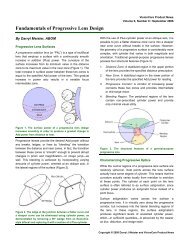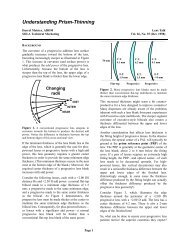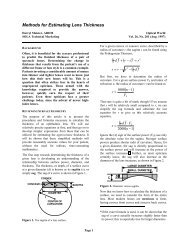OpenOptix ABO Study Guide - Laramy-K Optical
OpenOptix ABO Study Guide - Laramy-K Optical
OpenOptix ABO Study Guide - Laramy-K Optical
You also want an ePaper? Increase the reach of your titles
YUMPU automatically turns print PDFs into web optimized ePapers that Google loves.
Photochromic Lenses<br />
Photochromic is a generic term to define a lens with a characteristic of changing state<br />
from clear to sunglass dark when exposed to light. Over the years this option has been<br />
available in many different chemical, material, and color combinations; as well as offered<br />
by many different manufacturers with varying methods for application. Below is a list of<br />
the most popular flavors of photochromic lenses and a brief overview of the technologies<br />
and the companies that produce them.<br />
Transitions<br />
Transition lenses were created by PPG Industries (Pittsburgh Plate Glass Company).<br />
Transitions lenses use a technology called imbibing to place the photochromic dye<br />
photosol a few microns below the front surface of the lens. The advantage is that the<br />
lenses can be surfaced to a very thin center thickness without worry of the photochromic<br />
properties being changed. This technology also allows for uniform color in cases where<br />
the thickness between right and left lens varies. Transitions is available in a CR-607<br />
monomer 1.5, a CR-424 UV curable monomer 1.55, and a urethane 1.67.<br />
PGX/PBX<br />
Photo Grey Extra and Photo Brown Extra are the original glass versions of a<br />
photochromic lens. These lenses used an en masse technology which had the dye mixed<br />
throughout the entire lens. A large disadvantage to en masse technology s the fact that<br />
with varying thicknesses the lenses would have a slight variance in color, this is apparent<br />
in plus lenses with darker centers and minus powers with lighter centers. The chemical<br />
commonly used in these lenses is silver halide which is also a popular dye used in<br />
photography for film and paper.<br />
Sunsensors<br />
Sunsensors are an en masse plastic technology created by Corning. Corning offers this<br />
lens in a 1.56 material. Sunsensors use an en masses technology yet lenses will match one<br />
another even with varying thicknesses and powers, the idea behind this is that only the<br />
surface dye is activated so no matter the variation in thickness the UV light is absorbed<br />
and activates the same amount of chemical in the surface of the lens.<br />
LifeRx<br />
LifeRx lenses were created by Vision Ease to fill a niche for polycarbonate FT<br />
photochromics. The technology used to create theses lenses is a dye film that is applied to<br />
the lens similar to a polarized film. The advantage is that FT polycarbonate photochromic<br />
This document is licensed under the Creative Commons Attribution 3.0 License. 7/30/2009<br />
36









